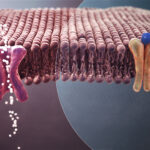Feeling Brain Fog? It Could Be in Your Blood
Brain fog accompanying long COVID could be the result of breaches in a cellular barrier protecting the brain.
We all have our “brain fart” moments. We may forget where we put down our keys, take a bit longer to calculate our tips, or struggle to find that word on the tip of our tongues. “Brain fog” is another apt (maybe less crass) term to describe these periods of mental slowness. We might describe ourselves as “feeling foggy,” like we’re working through a haze. The feeling might even stretch on for days, weeks, or months…and in the wake of COVID-19, more people have been experiencing it than ever. But what exactly is it, and what about COVID makes people vulnerable to it?
What is brain fog?
Brain fog isn’t a medical condition but instead a term used to describe changes in our cognitive functioning—how we think and reason. It can include memory problems, difficulty focusing, or changes in executive function (how you decide and plan your actions). Brain fog isn’t unique to COVID. A number of illnesses or conditions can cause brain fog. These include anything from pregnancy to certain medications to plain old stress.
Brain fog can occur during short or long bouts of COVID. “Long COVID” is when the all-too-familiar symptoms of COVID infection—such as loss of taste and smell, fatigue, coughing, and/or shortness of breath—last over a month post-infection. COVID brain fog can last for a while. In one recent study where COVID-positive individuals were tested on their cognitive performance, 23 percent showed signs of brain fog more than 6 months post-infection. Of those people, 43 percent still showed signs at more than 18 months.
RELATED: Long-Term Effects of COVID-19 Infection
It’s not yet understood why the effects of COVID stick around so long in some people…and why some of these people get lost in a seemingly never-ending fog. Chris Greene and colleagues from Trinity College Dublin and partnered institutions in Ireland sought to better understand these cognitive symptoms of long COVID, focusing on an intriguing target: the blood-brain barrier.
The blood-brain barrier: a bouncer to your brain
Usually, nutrients and other important molecules in your blood reach your body’s tissues by passing through a thin layer of cells which border your blood vessels. However, your brain is a delicate organ. It requires a very carefully regulated mix of nutrients to function properly. It’s also very susceptible to infection by agents like viruses or bacteria.
So, in the vessels supplying your brain and spinal cord, the bordering cells are more tightly packed together, so that no undesired molecules or pathogens can slip through the cracks. This extra-protective layer of cells is called the blood-brain barrier, or BBB. It acts like a security guard for your brain: deciding what can enter the brain tissue, and what should stay in your blood.
The BBB may not work as well under certain conditions. It becomes less effective as people age, for instance. It can also be damaged by a stroke, or by some infections. In fact, previous evidence has suggested that SARS-CoV-2, the virus which causes COVID, is one such virus that can compromise the BBB. Researchers had previously observed damage to blood vessels in postmortem brain tissue from COVID-positive patients. But it was unknown whether such damage might have functional consequences for the brain—that is, if it could be linked to brain fog.
MRI imaging of the barrier
In their study, the researchers wanted to look at the BBB in living patients who had either recovered from COVID or still had long COVID with or without features of brain fog. To do so, they used a type of imaging called dynamic contrast-enhanced magnetic resonance imaging, or DCE-MRI. This is a type of MRI scan, like the one you might have at a doctor’s appointment.
MRI scans work by manipulating a tiny amount of magnetism that is present inside of atoms, including the hydrogen atoms of the water molecules which exist throughout your body. A very strong magnet aligns all of these atoms to its magnetic field. Then, a short burst of energy (a radio wave) is used to knock the atoms briefly out of alignment. As they return to their original alignment, these atoms release a small amount of energy. The MRI machine records this energy and can use it to make inferences about where the atoms are. This allows doctors and scientists to get a detailed look at the inside of your body, as different parts of your body hold different amounts of water.
DCE-MRI is a type of MRI where a chemical called a contrast agent is injected into a subject’s blood before imaging. This agent contains atoms which respond uniquely to the magnets and radio waves of the MRI machine. This allows researchers to better visualize the blood in your body. This can be useful to assess the integrity of blood vessels, including the BBB.
Using this technique, Greene and colleagues found that, in patients with COVID brain fog, the BBB was more permeable; that is, the contrast agent spread into the surrounding brain tissues faster than normal. It was even more permeable than in people with long COVID who didn’t have brain fog. This suggested that the compromised filtering of blood components could be specifically related to the cognitive “slowness” of brain fog.
The increased permeability was particularly noticeable in the frontal cortex—the frontmost parts of the brain, which are involved in many features of cognition including executive function and attention. It was also higher in the temporal lobes—the parts of your brain by your temples, which are important to complex sensory functions, like visual and language processing.
RELATED: How Does Your Brain Work?
Hints in the blood
The researchers didn’t stop at MRI imaging. They also wanted to know what molecular signs of BBB dysfunction might linger in the blood of people with long COVID. So, they analyzed blood samples for proteins which reflect BBB integrity. They also looked for markers of immune responses, such as proteins called interleukins. These are signaling molecules that circulate in the blood to alert the body to an infection. The immune response is tightly tied to BBB integrity; the inflammation that helps fight an infection can also compromise or even structurally damage the BBB.
The research team found that several immune markers were increased across all groups with COVID. This included those who had already recovered from COVID and those with long COVID, with or without brain fog. Interestingly, a protein called TGFβ stood out as selectively increased in the individuals with brain fog. TGFβ has a complex set of roles in the body, including in immune response regulation and control of cell division. At the moment it’s unclear how TGFβ may contribute to brain fog, though it’s previously been implicated in chronic fatigue syndrome, where brain fog is common.
The state of the BBB and immune system can be inferred not only from what proteins are in our blood but also from what genes our blood cells are expressing. Genes are our cells’ “blueprint” for making new proteins, and their expression can be up- or downregulated according to the needs of the body. Our blood contains many immune cells, collectively called peripheral blood mononuclear cells (PMBCs), which express a variety of proteins to help to fight off infections.
RELATED: New Data on Protein Structure in Blood Cells
The researchers assessed the gene expression of the PMBCs in order to see if they were expressing proteins that contribute to immune responses, or anything else to indicate dysfunction of the BBB. They found that those who had long COVID with brain fog had many genes which were expressed differently in their PMBCs than the other groups. For instance, genes involved in coagulation were downregulated in those with brain fog. Coagulation is the process by which our blood clots. It often results from inflammation following an infection. Dysregulation of this process had been previously suggested to drive COVID severity. There were also many genes involved in the immune response that were expressed differently, including those that control the activation of T cells. These include “killer” T cells, which—as their name implies—kill off infected cells to protect the rest of the body.
Breaks in the barrier may dampen cognition
To sum up, a “leaky” BBB seems to be associated with the cognitive symptoms of long COVID, also called “brain fog.” There are also other changes in the body—such as in the immune system and coagulation pathway—which are associated with such symptoms.
While correlation does not imply causation—meaning, the changes in the BBB may not directly cause brain fog—that remains a distinct possibility, given the vital role we know it has in maintaining brain function. Future studies will be able to track people upon their initial infection with COVID to determine if the BBB disruption they experience makes them more likely to have long COVID and brain fog later on.
If so, however, this could open up new doors to treat the cognitive symptoms of long COVID. The BBB is already being explored as a therapeutic target to treat other conditions where its integrity is compromised, including Alzheimer’s disease. Such treatments could also have utility for long COVID patients.
But why is the BBB weaker in some people than others? It may simply result from the severity of infection. Some people may have a worse case of COVID because they had a greater infectious dose—that is, they were exposed to more viral particles at the time of infection. Perhaps this causes a greater disruption to the BBB and thus greater susceptibility to brain fog. Alternatively, pre-existing conditions can shape the baseline status of the BBB; for instance, in older individuals, the BBB tends to be weaker. So, they may also be at greater risk of brain fog upon COVID infection.
RELATED: Can COVID-19 Cause Parkinson’s Disease Later?
Another interesting question is how brain fog may vary among different variants of SARS-CoV-2. Previous studies suggest that different variants affect different cell types within the BBB. It’s possible this could translate to different susceptibilities toward cognitive symptoms.
Sadly, none of this offers a quick fix to the foggy thinking still plaguing so many. But the next time you forget your hair appointment or need to whip out your calculator for some simple addition, don’t blame yourself…try blaming your blood-brain barrier!
This study was published in the peer-reviewed journal Nature Neuroscience.
References
Greene, C., Connolly, R., Brennan, D., … & Campbell, M. (2024). Blood–brain barrier disruption and sustained systemic inflammation in individuals with long COVID-associated cognitive impairment. Nature Neuroscience, 27, 421–432. https://doi.org/10.1038/s41593-024-01576-9
Hartung, T. J., Bahmer, T., Chaplinskaya-Sobol, I., … & Finke, C. (2024). Predictors of non-recovery from fatigue and cognitive deficits after COVID-19: a prospective, longitudinal, population-based study. eClinicalMedicine, 69, 102456.
Lee, M. H., Perl, D. P., Nair, G., … & Nath, A. (2021). Microvascular injury in the brains of patients with Covid-19. New England Journal of Medicine, 384(5), 481–483.
Montoya, J. G., Holmes, T. H., Anderson, J. N., … & Davis, M. M. (2017). Cytokine signature associated with disease severity in chronic fatigue syndrome patients. Proceedings of the National Academy of Sciences, 114(34), E7150–E7158.
Galea, I. (2021). The blood–brain barrier in systemic infection and inflammation. Cellular & Molecular Immunology, 18(11), 2489–2501.
Proust, A., Queval, C. J., Harvey, R., … & Wilkinson, R. J. (2023). Differential effects of SARS-CoV-2 variants on central nervous system cells and blood–brain barrier functions. Journal of Neuroinflammation, 20(1), 184.


About the Author
Rebecca DeGiosio is a postdoctoral fellow at the Children’s Hospital of Philadelphia, researching gene therapy approaches to treat rare lysosomal storage disorders. Rebecca has a passion for translational biological research, particularly on psychiatric and neurodevelopmental disorders, and for making this research accessible to the public. Find her on LinkedIn: https://www.linkedin.com/in/rebecca-degiosio/.




